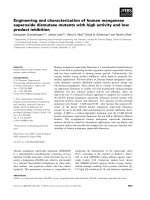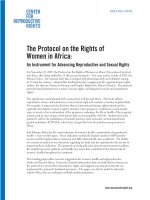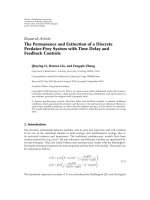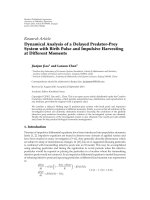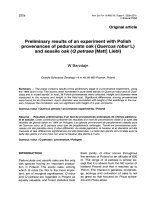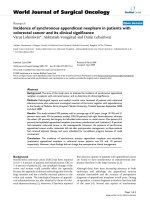Active modified atmospheric packaging of mango (cv. Dushari): An experiment with potassium permanganate and salicylic acid
Bạn đang xem bản rút gọn của tài liệu. Xem và tải ngay bản đầy đủ của tài liệu tại đây (372.81 KB, 7 trang )
Int.J.Curr.Microbiol.App.Sci (2018) 7(3): 2790-2796
International Journal of Current Microbiology and Applied Sciences
ISSN: 2319-7706 Volume 7 Number 03 (2018)
Journal homepage:
Original Research Article
/>
Active Modified Atmospheric Packaging of Mango (cv. Dushari): An
Experiment with Potassium Permanganate and Salicylic Acid
Ranjeet Singh1* and S.K. Giri2
1
AS&EC Division, ICAR-Central Institute of Post-harvest Engineering & Technology,
Ludhiana Punjab-141 004, India
2
APPD Division, ICAR- Central Institute of Agricultural Engineering, Nabi-Bagh, Berasia
Road, Bhopal 462 038, India
*Corresponding author
ABSTRACT
Keywords
Active modified
atmospheric packaging,
Ethylene absorbents,
Respiration rate and shelf
life
Article Info
Accepted:
24 February 2018
Available Online:
10 March 2018
In the present study, the use of salts such as Potassium Permanganate and
Salicylic Acid as an active ingredient to control and absorb ethylene
produced by the fruits during storage and extension of shelf life were
analysed. The shelf life of fruits by using modified atmospheric packaging
techniques along with refrigeration were correlated with various quality
indices such as in-pack gas, firmness, color, physiological loss in weight
(PLW), total soluble solids, ascorbic acid and percent decay in fruits. The
study was planned to examine the efficacy of Active Modified Atmospheric
Packaging of Mango to enhance its shelf-life with quality keeping in view
the export potential of fruits to foreign countries.
Introduction
MAP is a multidisciplinary technology of
maintaining freshness and extends shelf life.
There are many advantages of MAP of fruits
and vegetables, but the most obvious one must
be the extension of shelf life. MAP
technology, which utilizes only the natural
components of air, has achieved public
acceptance due to these two trends (GonzalezAguilar, et al., 2004). MAP has the
advantages that synthetic chemicals are not
used, no toxic residue is left, and there is little
environmental impact, particularly if the
plastic films used can be recycled. Recent
advances in the design and manufacture of
polymeric films with a wide range of gasdiffusion characteristics have also stimulated
interest in MAP of fresh produce. In addition,
the increased availability of various absorbers
of O2, CO2 (Kader et al., 1997), water vapour
(Varoquaux et al., 1996), and ethylene (C2H4)
(Talasila et al., 1994) provides possible
additional tools for manipulating the
microenvironment of MAP. There is extensive
literature on the benefits of MAP along with
use of absorbents for the dramatic extensions
of shelf life for various foods (Kader et al.,
2790
Int.J.Curr.Microbiol.App.Sci (2018) 7(3): 2790-2796
1997). Ethylene is the natural product of plant
metabolism and is produced by all tissues of
higher plants and by some microorganisms. It
is the simplest of all the organic compounds
and considerably affecting the physiological
processes of plants and the commodity after
harvest (Aharoni et al., 1987). Exposure of
climacteric fruits to ethylene advanced the
onset of an irreversible rise in respiration rate
and rapid ripening. Various packages can
delay the onset of climacteric and prolong
shelf life of fruits by reducing ethylene
production and sensitivity (Fonseca et al.,
2000). Keeping in view, the present study was
designed to evaluate the efficacy of ethylene
absorbents Potassium Permanganate and
Salicylic Acid to extend shelf-life fruits for
export market.
Materials and Methods
Fruit material
The fruit Mango (cv. Dushari) of uniform
size, without defects or diseases were
handpicked/harvested at their commercial
maturity from farm.
They were visually inspected for freedom
from defects and blemishes and non-uniform,
damaged, poor quality was removed. Fruits
were also exposed to UV light for surface
disinfestations and given pre-hot air treatment
at 49oC for 10 min.
Active packaging with modified atmosphere
storage
For active packaging, experiments was carried
out with treatments of MAP with Potassium
permanganate
as
ethylene
absorbent
(refrigerated),
MAP
with
Potassium
permanganate (PP)+ salicylic acid (SA) as
ethylene absorbent (refrigerated). The sachets
were prepared @ 9 g silica crystals per kg of
packed fruits by filling pure potassium
permanganate imbedded in silica crystals in
woven polyester cloth with high permeability
(Singh et al., 2014a). The fruits were dipped
in Salicylic acid @ 0.15g/lit, before packaging
experiments. The treatment bags were
immediately shifted and were stored at storage
temperature (14±1oC) and 95% relative
humidity (RH) in environmental control
chamber. The experiments were also done for
control storage in refrigerated conditions (CR)
at defined temperature.
Measurement
of
in-pack
composition and respiration rate
gaseous
The in-pack gaseous composition of O2 and
CO2 were analyzed in all MA packages during
storage using a portable headspace gas
analyzer (Model GS3M, Systech Instruments
Ltd. UK). The respiration rate (RR) of fruits in
term of CO2 librated (ml/kg-h) were
determined in all treatment packages during
storage as per the method adopted by Singh et
al., (2014b).
Design of packaging system
Evaluation of shelf life quality
Active modified atmosphere packages were
designed based on the respiration rates of the
products, film parameters and environment
factors. The respiration rate of mango fruits
was determined as per the method adopted by
Singh et al., (2013). Based on design
calculations using PACK-in-MAP software,
perforated LDPE film (75µm) was selected for
bulk packaging (10 kg) of fruits.
Shelf-life of fruit was assessed by various
quality parameters such as in-pack gas,
firmness, color, physiological loss in weight
(PLW), total soluble solids, ascorbic acid and
decay. Fruit firmness was analyzed by
measuring the maximum compression force
using Texture Analyzer Stable Micro Systems,
Model TA.XT. plus. The Data were recorded
2791
Int.J.Curr.Microbiol.App.Sci (2018) 7(3): 2790-2796
in triplicate and the mean values were
expressed as kgf. Color development of fruit
(skin) was measured at harvesting and during
storage using a colorimeter (chroma-meter)
(Miniscan XE plus, Hunter associates, USA).
PLW was measured by using hand held
refractometer. The color of the fruit was
measured on every 7th days of storage, the ‘L’,
and ‘a’ values were recorded as an average of
15 measurements. Physiological loss in weight
was determined by weighing all samples with
a laboratory level weighing scale (Model CT35K2, Contech Instruments Ltd. India) having
least count ±2g at the beginning and end of the
storage period.
Results and Discussion
In-pack gas composition
In pack gaseous composition in terms of O2
depletion and CO2 evolution during the
storage of matured mango fruits (cv. Dusheri)
in different packaging system at 14±1oC
temperature is showed in plate 1. It was
observed that, by the end of day 7, a rapid
decline in O2 and subsequently rapid increase
in CO2 evolution set-in both the MAP (PP)
and MAP (PP+SA) treatments and then
maintained steady state thereafter.
Physiological loss in weight (%)
The difference between the two values was
considered as weight loss and expressed in
percentage. Ascorbic acid was determined
using the 2,6 dichlorophenolindophenol
method (ΑOAC 1990) and expressed in mg
per 100 g of the initial fruit mass.
Measurements were taken at the beginning
and on every 7th days of storage.
Measurements of the ascorbic acid were
carried out in all packaging treatment, as an
average of 3 measurements. Percentage of
decay was obtained from the number of fruit
that showed signs of decay over the initial
number of fruit. The cumulative decay during
storage period was recorded and expressed as
a percentage. The percent samples excluding
decay after end of the storage period represent
marketability.
Statistical analysis
The experimental data were analyzed using
GLM procedure available in SAS (SAS
Institute India Pvt. Ltd.). Completely
Randomized Design (CRD) was used in the
experiment. The significance of different
methods, their pair wise comparison and
estimations of coefficients were carried out.
The pair wise comparison was performed
using Tukey's Studentized Range (HSD) Test.
Among all the packaging treatments, the
control sample (CR) showed significant
increase in physiological weight loss.
However, the PLW was very minimal in both
the MAP (PP) and MAP (PP+SA) refrigerated
samples during and by the end of the storage
period with no visible formation of water drips
and fogging in the packages. The use of
imbedded silica crystals sachets under active
packaging acted as anti-fogging and reduced
water drips and moisture loss and significantly
reduces PLW (Plate 2).
Fruit firmness
The firmness of fresh fruits was 26.17 kgf. A
continuous decline in fruit firmness was
observed in all the packaging treatments by
the passage of storage period. Fruit firmness
was significantly protected by both the MAP
(PP) and MAP (SA) samples by the end of day
49, respectively. However, a steep and
significant decline in fruit firmness was
observed for the control (CR) sample by the
end of day 21 respectively (Plate 3). In MAP
(PP+SA) refrigerated, fruit firmness finally
settled at 2.11 kgf, respectively by the end of
storage period of 42 and 5 days at room
temperature.
2792
Int.J.Curr.Microbiol.App.Sci (2018) 7(3): 2790-2796
Plate.1 In-pack gaseous composition
Plate.2 Physiological loss in weight (PLW, %)
Plate.3 Fruit firmness during storage
2793
Int.J.Curr.Microbiol.App.Sci (2018) 7(3): 2790-2796
Plate.4 Total soluble solid content
Plate.5 Hunter ‘a’ value of fruits during storage
Plate.1 MAP (PP+SA) packed fully ripe mango after 6 weeks in refrigerated MA storage (a) and
addition 5 days storage at room temperature (b)
(a)
(b)
2794
Int.J.Curr.Microbiol.App.Sci (2018) 7(3): 2790-2796
Table.1 Comparative table of quality indices of mango
Pack Size, kg
Type of film / thickness
No of holes (0.5mm dia) per side of film.
Storage temp, oC
Pre-treatment
Absorbent used
10
LDPE / 75 µ
10
14
Hot air 49-50oC for 10 min
Potassium permanganate and salicylic acid
as ethylene absorbents
5
Enhanced shelf life under MA technique,
weeks
Estimated packaging cost (Rs./kg)
5
Total soluble solids (TSS)
An increasing trend in total soluble solids
(TSS) content was observed in all the MAP
and control samples. The TSS content was
found maximum in control (refrigerated
sample) by the end of day 21 followed by
MAP (PP) and MAP (PP +SA) refrigerated
samples (Plate 4).
Color ‘a’ value
The green color of both the MAP (PP) and
MAP (SA) treatments were well protected by
the packaging treatments during storage up to
day 42. After 21 days sharp change in green
color depicted by hunter ‘a’ value was
observed in both the MAP (PP) and MAP
(SA) packages. After wards steady state
conditions were observed (Plate 5).
Fruit decay (%)
The major sign of decay in mango fruit in all
packaging treatments are one or in
combinations of the following: skin abrasions,
low temperature injury, soft nose and
pathological disorders like Anthracnose. The
decay was largely exhibit in control (CR)
fruits and significantly differs with MAP (PP)
and MAP (PP+SA). Package treatment CR
had maximum decay of more than 15 % by
the end of storage life (day 21). MAP (PP)
and MAP (PP+SA) treatment had minimum
decay value of 3.9 % and 2.10 % by day 35
and day 49, respectively. The fruit decay in
active packaging was significantly reduced by
the use of Ethylene absorbents (PP+SA)
sachets during storage period.
Shelf life
Modified atmospheric packed mango in 75µm
thick LDPE package, with ethylene
absorbents (PP+SA) was found to have a
shelf-life of 42 days at refrigerated conditions
plus 5 days at ambient after opening of MA
packages. Into the shelf life was enhanced
upto 6 weeks + 5 days. However, the control
fruits had a shelf-life of 12 days. The
comparative table of quality indices were
given in Table 1.
The use of ethylene absorbent/ moisture
absorbent along with modified atmospheric
packaging as a postharvest tool may be
adapted into the supply chain activities of the
above produces to enhance storage life and
ensure quality during distribution to
local/super markets and to maximize
customer value.
Acknowledgement
The authors are highly grateful to the
Director, ICAR-CIPHET, Ludhiana and
2795
Int.J.Curr.Microbiol.App.Sci (2018) 7(3): 2790-2796
ICAR-CIAE, Bhopal for the support and
encouragement to carry out the work.
References
Aharoni, N., Philosoph-Hadas, S and BarkaiGolnn, R. (1987) Modified atmosphere
to delay senescence and decay of
broccoli. Proceedings of 4th National
Controlled
Atmospheres
Research
Conference July 1985. North Carolina,
169-177
Fonseca, S.C., Oliveira, F.A.R., Lino, I.B.M.,
Brecht, J.K, and Chau, K.V. 2000.
Modeling O2 and CO2 exchange for
development of perforation mediated
modified atmosphere packaging. J of
Food Engng, 43 (1), 9−15
Gonzalez-Aguilar, G., Ayala-Zavala, J.F,
Ruiz-Cruz, S., Acedo-Felix, E and
Diaz-Cinco, M.E. 2004. Effect of
temperature and modified atmosphere
packaging on overall quality of freshcut bell peppers. Lebensm.-Wiss. u.Technol., 37: 817–826
Kader, A. A. 1997. A summary of CA
requirements and recommendations for
fruits other than apples and pears. In A.
A. Kader (Ed.), Proceedings of the 7th
international controlled atmosphere
research conference, 3: 1–34, Davis,
CA, USA
Singh, R. and Giri, S. K. 2014b. Respiration
rate model for mature green capsicum
(Capsicum annum L.) under closed
aerobic
atmospheric
conditions,
Croatian J of Food Sci and Technol., 6
(2): 110-115.
Singh, R., Giri, S. K. and Kotwaliwale, N.
2014a. Shelf-life enhancement of green
bell pepper (Capsicum annuum L.)
under active modified atmosphere
storage, Food Pac & Shelf life., 1 (2):
101-112
Singh, R., Giri, S. K. and Kulkarni, S. D.
2013. Respiratory behaviour of mature
light green Guava Psidium guajava L.)
under closed system, Sci J of Agric.
Engng., 1: 23-29
Talasila, P.C., Cameron, A.C and Joles, D.W.
1994. Frequency distribution of steadystate oxygen partial pressures in
modified atmosphere packages of cut
broccoli. J of the Am. Soc. for Horti.
Sci, 119: 556–562
Varoquaux, P., Mazollier, J and Albagnac, G.
1996. The influence of raw material
characteristics on the storage life of
fresh-cut butterhead lettuce. Post harv.
Bio. & Technol, 9: 127–139
How to cite this article:
Ranjeet Singh and Giri, S.K. 2018. Active Modified Atmospheric Packaging of Mango (cv.
Dushari): An Experiment with Potassium Permanganate and Salicylic Acid.
Int.J.Curr.Microbiol.App.Sci. 7(03): 2790-2796. doi: />
2796
